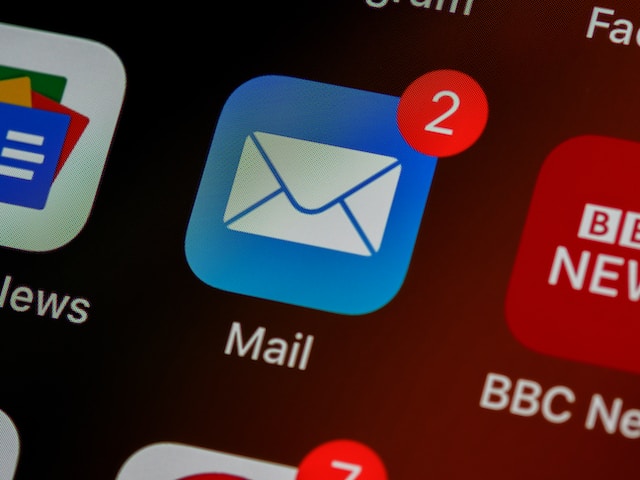Email marketing has been a staple for decades now, and continues to be an essential strategy even with the rise of SEO and social media. Its tried and tested effectiveness, efficiency, and potential for fostering meaningful connections with customers keep it relevant in today’s digital landscape. When used strategically alongside other marketing efforts, email marketing can make significant contributions to your business’s success. In fact, in a recent survey, 59% of customers said that marketing emails have influenced their purchases.
59% of customers say that marketing emails have influenced their purchases.
So, whether you’ve never sent a marketing email before or you’re not getting the results you’ve hoped for, this guide is for you. We’ll explore what email marketing is, what its key benefits are, as well as how to build an email marketing strategy and measure its success.
In this guide:
- What is email marketing?
- The different types of marketing emails
- The benefits of email marketing
- How to build an email marketing strategy
- How to write a compelling marketing email
- How to build and grow your mailing list
- How to measure and analyze email performance
Ready? Let’s find out more about email marketing!
What is email marketing?

Email marketing is a digital marketing strategy that involves sending commercial messages, promotions, updates, or informative content to large groups of people via email. It’s a consent-based type of marketing that requires consumers to opt in and allows them to unsubscribe at any time.
Email marketing has two main roles as part of a business strategy. The first is data collection — by using tools to track and analyze the click-through and opening rates, you can develop a better understanding of what customers respond to. This data can help you when it comes to designing sales and offers, developing new products, and much more. It can also help improve your email marketing strategy so it can perform well in its second role — increasing sales and customer conversion.
Because emails are sent directly to individuals, it’s very easy to personalize the content sent out to each customer. In fact, 60% of e-commerce and consumer goods companies personalize email content based on past purchases. Using data insights, you can tailor your messaging so that it resonates with customers, increasing the chances of them clicking on a link to your website and making a purchase.
60% of e-commerce and consumer goods companies personalize email content based on past purchases.
It’s easy to think email marketing is dated in the current climate as social media is so prominent. But email marketing still retains a competitive edge. Why? Because you have a direct line of contact with your customers with no algorithms getting in the way. You can get great results for a much lower investment. Social media might be the word on everyone’s lips, but no successful business is without an email marketing strategy to work alongside its social media marketing efforts.
The different types of marketing emails

There are a few different types of marketing emails to choose from, and you can focus on just one type or experiment with multiple.
Newsletters
The point of the newsletter is not to sell something but to provide informative and educational content that customers want to engage with and learn from. For a skincare brand, for example, a newsletter might include exclusive skin care tips, or for a kitchen appliance store it might feature exclusive recipes.
Along with updates and offers, it’s customary to offer customers another form of value that doesn’t connect back to profit and obvious business strategy. By doing this, you can develop a bond of trust and loyalty that will encourage better responses to other emails that are trying to sell something.
Blog post newsletters
Blog post newsletters are a great way to promote one of your other marketing strategies — your company blog. You can create a “catch-up” marketing email that introduces your featured posts of the month, or focus on a single new post that you want to highlight.
All you need to do is give the email a hook, introduce the blog post and the main points of its content, and link to it.
Offers and promotions
This is where you start selling your products more directly. Offers and promotional emails provide exclusive discounts and deals to your customers while spotlighting your offering and increasing your product awareness, so there’s value on both sides.
Your subject line should get straight to the point and cover what you’re offering — such as buy one get one free, 50% off, or free shipping. This, of course, grabs a user’s attention and gets them to open the email. Then, the body of the email can flesh out the details and provide a link straight to the applicable product page.
Business or product announcements
When you have something bigger to announce than an offer or promotion, say a new product launch or brand collaboration, you send out an announcement post. These get your existing customers hyped about making a new purchase. It can be a great place to tell the story or add some exclusive details about your new offerings, or link to a blog post that goes into detail. Don’t forget to link to the product page with a CTA, as well.
The benefits of email marketing
Email marketing is a superbly personalizable and versatile strategy that comes with a range of benefits — some of which can’t be matched by other marketing tactics.
High ROI
For every dollar you spend on email marketing, you make $36. That’s an impressively high ROI, especially compared to social media marketing which tends to return around $2.80 for every dollar spent.
Immediate results
Your subscriber list will start growing as soon as you give customers the chance to sign up, and the majority of your opens, clicks, and purchases will happen on the very day you send out an email.
Personalized promotion
Using data collected from various channels, including previous marketing emails, you can create systems that send customers exactly what they want to see. This not only increases the value you bring to your readers but increases the chances of them making a purchase too.
Build lasting relationships
When you employ a good email marketing strategy that isn’t spammy or annoying, customers stay on your subscriber list for multiple years. This allows you to make regular contact with customers over a long period of time and establish a place in their daily life. Through this kind of relationship building, you can become their go-to brand — the place they think of first when they need a product and the place that comes to mind when a friend needs a recommendation.
How to build an email marketing strategy

Building an email marketing strategy is an iterative process. You need to try new things out, measure their success, and make changes according to the results. Here’s a breakdown of the process.
Determine your aims and objectives
Use the data you already have on your customers and their habits to determine what they like, what matters to them, and what they find valuable. This information will help you encourage customers to sign up and create content that keeps them subscribed.
Then, you need to decide what you want to accomplish — do you want to promote products, services, a blog, website visits, or a bit of everything? You’ll also need to do some research to set in-depth targets, like the open rates and click-through rates you want to achieve and when you want to achieve them.
Define your audience and mail lists
If you want to send out different types of emails, you can give subscribers a chance to choose which types they’re interested in. Some people aren’t into newsletters but love to be alerted when a sale starts, for example. To set this up, define the types of audiences you want to reach with each type of email and segment them. You can also segment customers based on their data and send them content based on their habits. For example, someone who visited the site and signed up but hasn’t made a purchase yet should receive different content from a monthly purchaser.
Plan your campaigns
Planning your campaigns means choosing the type of emails you want to send and making a schedule. There’s a lot of advice out there on what email types are best and how many you should send but the right answer depends on your type of business. There definitely is such a thing as too many emails, though — data shows that results can start to worsen if you exceed more than five emails a week.
A/B test
A/B testing is an absolute necessity when it comes to email marketing. By sending out multiple versions of the same email, you can collect data about which version performs the best and use that information to develop a style and content guide you can apply to your entire campaign.
Whenever you’re torn between two or more potential fonts, opening lines, CTAs, color schemes, or any other element of your email, there’s no need to sit and stew over the decision. Simply set up a quick A/B test and let the readers decide.
Measure the results
Results are the whole reason you have an email marketing strategy, so it’s important to keep an eye on them. Your analytics page is something you can check daily and use to inform new ideas and improvements to your strategy.
How to write a compelling marketing email
Marketing emails need to be snappy, attention-grabbing, concise, and easily digestible. Here are some email marketing tips on how to structure and write great content.
- Choose powerful subject lines: Don’t be scared of having “spoilers” in your subject lines — if anything, that’s exactly what they should be. Whatever the main takeaway, most compelling point, or primary goal of the email is, that’s what your subject line should be. This is what inspires people to open the email and find out more.
- Personalize the messaging: Email marketing software, along with the masses of customer data you collect, can craft highly personalized email content. The email should of course always address the customer by name, take into account past purchases and buying habits, and even draw on profile information like age and gender.
- Emphasize the benefits: Never leave your readers wondering about the purpose of your email. Make your message clear and emphasize the benefits your customers can reap by taking you up on your offer.
- Make it digestible and visually pleasing: No chunky paragraphs are allowed here. Emails need to be broken up into very small chunks — if you think a new line for every sentence is too much, think again. People check their emails on all sorts of devices, and small paragraphs are the easiest to read on a small screen. Headers, fonts, colors, and images are all welcome elements, as well.
- Inspire action with a clear CTA: End your email with a call to action that’s clear and obvious — and make it a button so readers who want to learn more have no difficulty getting to where they need to be. As a rule, you shouldn’t mention anything on your site without also linking to it since such obstacles severely affect action.
How to build and grow your mailing list

There are all sorts of ways to grow your mailing list. You can attract potential first-time buyers as soon as they click on your site with a pop-up that offers a promotion in exchange for an email address. This is great for e-commerce sites that sell branded products, as it gives new customers the chance to get what they want for a better price. You can also encourage people to subscribe when they’re making a purchase with a simple tick box for consenting to marketing emails.
Your landing page can become a conversion point too by creating an eye-catching form and letting it do its job. To really make this work though, you’ll need to make use of lead magnets. These are examples of instant value visitors can get when they sign up. Some common examples include a free ebook, video, case study, or template filled with exclusive information.
How to measure and analyze email performance
Measuring the success of your marketing emails is quite straightforward — all the information you want to know is what you’ll have access to through your analytics software. Here are some of the key metrics companies use to assess their email marketing campaigns.
- CTR (Click-Through Rate): This metric tells you what percentage of recipients clicked a certain link in your email.
- Conversion rate: “Conversion” is the term used when a reader completes a desired action. For an e-commerce site, for example, the main desired action is making a purchase.
- Forward and sharing rates: As the name suggests, this data counts how many people forward your email to a friend or interact with a “share this” button in your email.
- Open rates: Open rates show you how many emails sent are opened. This metric works best in tandem with others since lots of people open an email just to get rid of the unread mark.
- Unsubscribe rates: This is the percentage of email addresses that unsubscribe from your mailing list. Because the unsubscribe option is on the email itself, you can even see what triggered them to unsubscribe.
There are many more metrics out there you can measure but not all of them will be suited to your business goals. It’s important to track the metrics that give you relevant information and insights into your marketing strategy. When you’re starting out, the most important things to track are the health of your mailing list, the performance of each email and email type, and your progress toward your goals.
In the end, one of the most compelling reasons to start an email marketing campaign is the high ROI. It means you can start easily, and you’re free to keep making changes without losing anything. Another reason is that everyone is doing it — business owners are consumers too, and you no doubt see CTAs to sign up for mailing lists on just about every site you visit.
Work with a content marketing agency
When you’re ready to join the gang, you can make the experience even smoother by skipping the learning curve and working with experts. Reach out to Scribly today for full-service B2C content marketing support that lets you sit back and relax while the results roll in.



